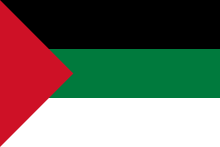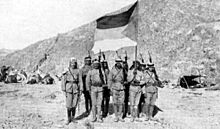Flag of the Arab Revolt

 Flag ratio: 1:2
Flag ratio: 1:2
The Flag of the Arab Revolt was a flag used by Arab nationalists during the Arab Revolt against the Ottoman Empire in World War I.
History
The flag was designed by the British diplomat Sir Mark Sykes, in an effort to create a feeling of "Arab-ness" in order to fuel the revolt.[1] Although the Arab Revolt was only very limited in scope and concerted by the British rather than by Arabs themselves, the flag influenced the national flags of a number of emerging Arab states after World War I. Flags inspired by that of the Arab revolt include those of Egypt, Jordan, Iraq, Kuwait, Sudan, Syria, the United Arab Emirates, Yemen, the Palestinian National Authority, Somaliland and the Sahrawi Arab Democratic Republic and formerly of Libya.

The horizontal colors stand for the Abbasid, Umayyad and Fatimid Caliphates. The red triangle refers to the Hashemite dynasty.
The Hashemites were allies of the British in the conflict against the Ottoman Empire. After the war ended, the Hashemites achieved or were granted rule in the Hejaz region of Arabia, Eastern (Transjordan) Palestine, formally known as the Hashemite Kingdom of Jordan, briefly in Greater Syria, and Iraq.
Greater Syria was dissolved after only a few months existence, in 1920. The Hashemites were overthrown in the Hejaz in 1925 by the House of Saud, and in Iraq in 1958 by a coup d'etat, but retained power in Jordan.
A 98.5 by 197 foot version of the flag flies from the Aqaba Flagpole, currently the second tallest freestanding flagpole in the world, located in Aqaba, Jordan.
References
- ^ William Easterly, The White Man's Burden, (2006) p. 295
See also
